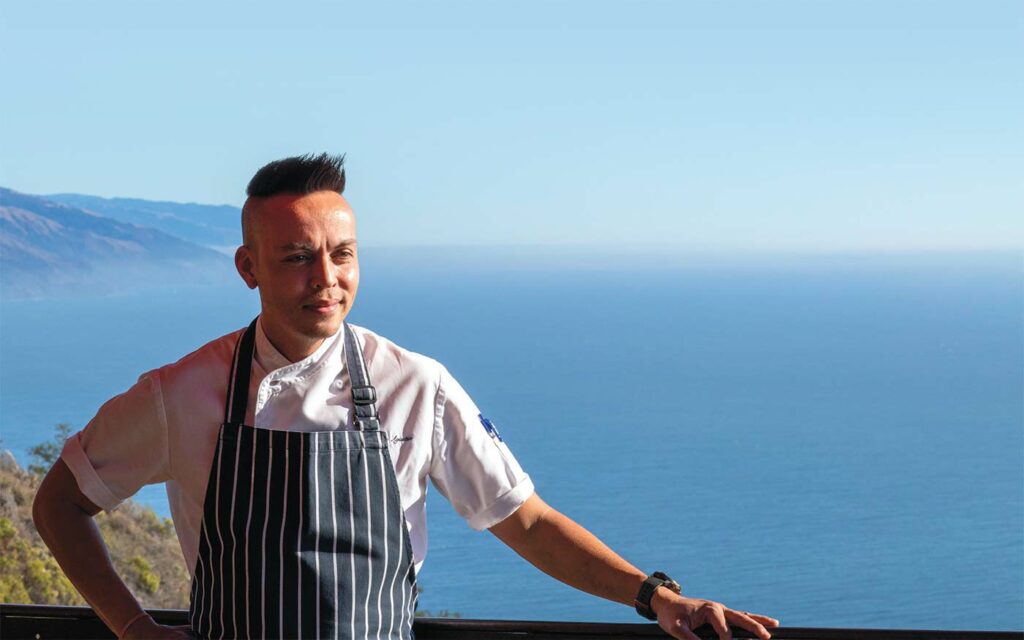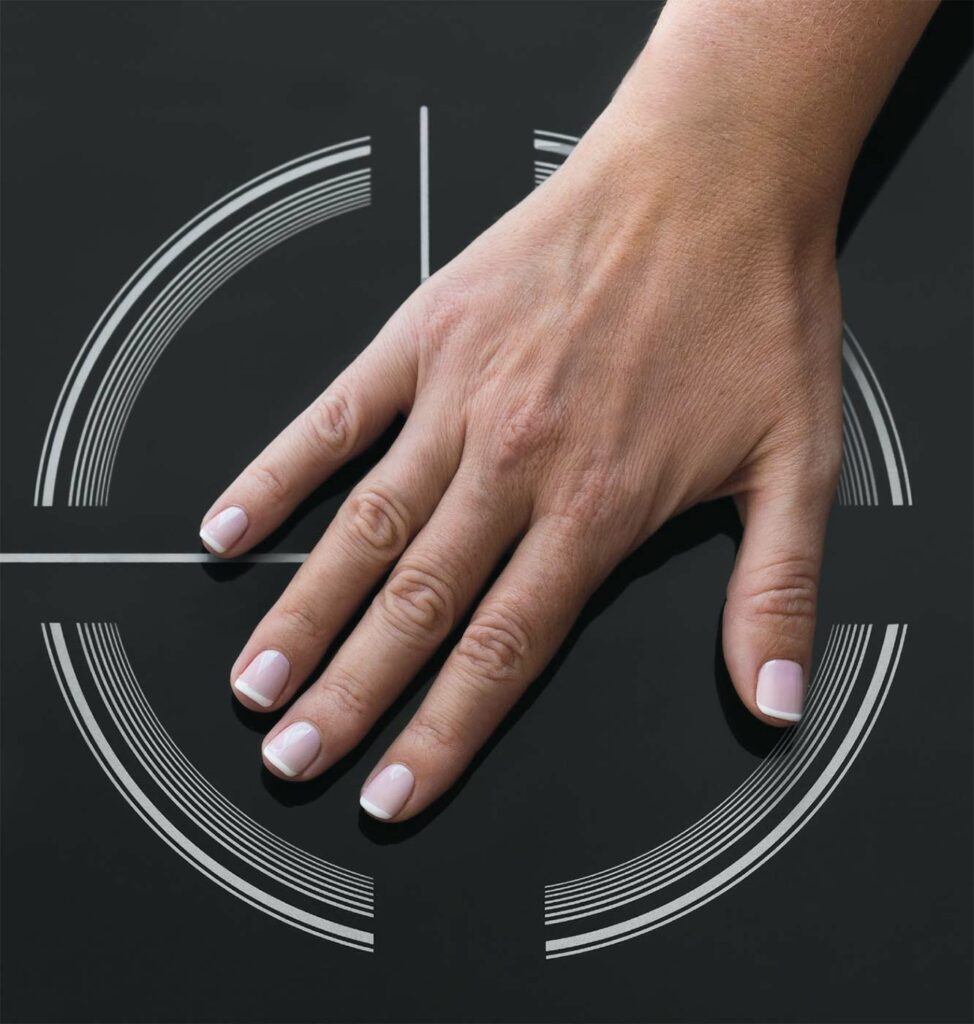
Perched on the edge of a cliff high above the Pacific Ocean, the dining room of the iconic, eco-friendly Post Ranch Inn’s Sierra Mar restaurant is on summer days as pleasantly comfortable as you’d imagine it to be. But its kitchen is different. Heat waves sometimes send the kitchen’s cooking and cooling equipment into expensive, unhealthy and environment-harming battles for control of the temperature. On particularly hot days, when the sun spikes temperatures outside, the air conditioning system becomes overwhelmed by waste heat radiating from Sierra Mar’s three continuously burning 36,000-BTU French top gas ranges, and the kitchen temperature can breach 100° F. “This kitchen is too hot,” says Sierra Mar’s culinary director Reylon Agustin.
But Agustin plans for all that to change by next year. He is unhooking his gas line and switching to an all-electric kitchen, anchored by ranges that heat with induction—an extremely efficient alternative to gas or conventional electric stove technology that channels almost all of the energy it uses into cooking food, leaving both cooks and the climate cooler and healthier. The plan is part of Post Ranch Inn’s commitment to become a net-zero carbon emitter by 2025. It is estimated just getting rid of the gas stoves will cut 4.2 metric tons of direct carbon emissions and 1.2 tons for the cooling they require.
Agustin expects that savings in energy, labor and cleaning costs will recoup the purchase price of the new Garland stoves within four to five months and save more than $9,000 in operating costs annually. He also believes that their greater speed and higher performance will make cooking with them more rewarding than cooking with gas—and will even allow the restaurant to turn more tables, enhance staff retention and waste less food.
“It’s up to us to be the agents of change. We have to think of a better way,” Agustin says, noting that gas stoves can be viewed as just another toxic aspect of restaurant culture whose time is up.
Gas stoves can be viewed as just another toxic aspect of restaurant culture whose time is up.

THE CASE FOR INDUCTION
In the city of Santa Cruz, as in a growing number of municipalities around the country, gas hookups are not even allowed in newly built homes. The regulation is a response to the climate crisis and aims to reduce greenhouse gas emissions by getting residents to use less fossil fuels and more electricity—which is available from 100% renewable sources on the Central Coast. Natural gas got its clean reputation for being more efficient and clean burning than coal, but its main component, methane, is both a fossil fuel and a powerful greenhouse gas.
When burned, it emits carbon dioxide and harmful pollutants, and when released unburned, its 20-year climate-warming impact is more than 80 times as damaging as carbon dioxide’s. According to scientists at Stanford University, the 40 million residential gas stoves in use in the U.S. leak enough methane—mostly when turned off—to cause as much climate warming as a half-million gas-powered cars.
Meanwhile, federal regulators—long after mandating that gas furnaces and hot water heaters vent directly outdoors and that gas-powered cars use catalytic converters to cut their carbon monoxide and nitrogen dioxide emissions into the atmosphere—are considering regulating gas stoves due to hazards posed by these same pollutants, and others like benzene, formaldehyde and fine particulate matter, which the stoves release right into homes.
Scientists have tied pollutants expelled by gas stoves to asthma and other respiratory illnesses, heart disease, cancer, reproductive effects, diabetes, adverse brain development and impaired cognitive function. Children, due to their immature immune and respiratory systems, higher breathing rates and higher lung surface to body weight ratios, are particularly vulnerable. A study published by the Rocky Mountain Institute (RMI), The University of Sydney and the Albert Einstein College of Medicine in December, 2022, attributes 20.1% of childhood asthma in California, and 12.7% childhood asthma in the U.S. overall, to gas stove use. Ventilation—turning on a range hood that vents to the outdoors or opening a window, for example—reduces but doesn’t eliminate gas stove pollution. Burning propane also emits harmful pollutants. The cleaner method of cooking, the RMI report concludes, is electric.
Indeed, if you’re in the market for a new stove, the reasons to consider induction are rapidly multiplying, and the old drawbacks are diminishing.
What’s more, it’s never been easier to try induction out. In the Monterey Bay area, PG&E loans its customers portable single-burner induction cooktops, and offers induction consulting through Frontier Energy’s Food Service Technology Center (FSTC) in San Ramon. Frontier provides online instructional videos for the public and onsite help for professional chefs, including explanations of price incentives and the economics of going electric, training in induction technique and opportunities to try varied induction brands and models, all free of charge. If you want to buy your own single-burner induction cooktop and try it out, they can be purchased for $100 or less.
For those ready to purchase a full-size induction range or cooktop, but hesitating due to the roughly $1,000 minimum cost, the Inflation Reduction Act’s electrification incentive program will provide $840 rebates to families that earn up to 150% of the median household income in their area. Likewise, the IRA will offer up to $600 in tax credits and $6,500 towards new electrical panels and wiring upgrades. (See rewiringamerica.com for more.)

WHAT IS INDUCTION?
Induction generates heat by using an electrically charged coil of copper wire to create an electromagnetic field from beneath a cooktop’s smooth ceramic-glass surface. When a stainless steel, cast iron or other magnetic pan is placed on top, the field wirelessly induces an electric current in the pan, directly and instantly generating heat in the pan’s metal base.
With induction, in other words, the pan is the heat source, and the stove controls directly and immediately adjust the pan’s temperature, wasting only 8 to 15% of the energy used in the process.
Conventional electric stoves’ metal wire heating elements are less efficient than induction, but gas stoves’ open methane or propane flames are by far the least efficient: Just 32% of the energy they use goes into cooking and the remaining 68% is released in waste heat, making kitchens like Sierra Mar’s—and your own, if you use gas—so uncomfortable on hot days.
“Induction as a cooking medium is far superior to gas,” Agustin says he learned over several research trips to Frontier last year. He was most astonished by the power and speed that allowed him to boil two quarts of water in 42 seconds, and he finds induction allows a chef to cook anything with extraordinary control and efficiency.
To illustrate, Agustin says that if he wants to sear a pan of fish with induction, the stove and pan both heat up immediately, and induction’s even distribution of heat in the pan almost guarantees an even sear in all parts of the pan. Sierra Mar’s old French top gas ranges, by contrast, take at least 45 minutes to heat up, and attempting an even sear means then taking another 7 to 10 minutes to heat a sauté pan to full blast, and risking burning some of the fish.
Induction’s steady and precise power gradations also make it easier to hold consistent low temperatures, says Frontier’s consulting chef Mark Duesler, which can free cooks from using double boilers when tempering eggs or chocolate, or needing to watch low-simmering stocks closely.
Because induction just heats the pot, the rest of a range surface stays cool, reducing the risk of burns and eliminating the need to scrape off cooked-on spills. At Sierra Mar, induction will also mean no more carbon-caked pans, sooty range hoods and greasy drip pans, so Augustin is projecting a total 53% savings in energy and cleaning costs.
COOKING WITH INDUCTION AT HOME
There’s a learning curve to all of this, but the good news for home cooks is that if you prep your ingredients in advance—what chefs refer to as mise en place—and start low and slow with the temperature, you’ll likely find that induction makes you a better cook by both reducing cooking errors and making them easier to correct.
Your old Dutch ovens and cast iron, stainless steel and multiply pans should pass the refrigerator magnet test and work with induction; copper and other types of pots can be used if placed over a magnetic metal disk called a diffuser plate, but with much less efficiency.
On the negative side, some induction stoves offer less refined control than others, and some people find that some induction stoves emit annoying noises. Others fear they’ll miss the flame or the way that gas chars and smokes food. Pacemakers and insulin pumps are deal breakers, as induction can interfere with them.
But the cost savings with induction could be especially beneficial to small and struggling restaurants, Agustin believes. And without the gas and combustion fumes or the need to crank the heat up as much, professional and home cooks alike may find that induction makes food smell fresher and more vibrant.
“I feel like gas is like the old black dial-up phones we all had in our homes. They were simple, they were indestructible and they worked every time,” says Richard Young, director of Frontier’s FSTC, adding that while they weren’t replaced by smartphones overnight, nobody wants to go back. “I feel like once people get their hands on induction, they’re going to want to hang on to it.”
About the author
SARAH WOOD—founding editor and publisher of Edible Monterey Bay—has had a life-long passion for food, cooking, people and our planet.
She planted her first organic garden and cared for her first chicken when she was in elementary school in a farming region of Upstate New York.
Wood spent the early part of her career based in Ottawa, Canada, working in international development and international education. After considering culinary school, she opted to pursue her loves for writing, learning about the world and helping make it a better place by obtaining a fellowship and an MA in Journalism from New York University.
While working for a daily newspaper in New Jersey, she wrote stories that helped farmers fend off development and won a state-wide public service award from the New Jersey Press Association for an investigative series of articles about a slumlord who had hoodwinked ratings agencies and investment banks into propping him up with some early commercial mortgage securitizations. The series led Wood to spend several years in financial journalism, most recently, as editor-in-chief of the leading magazine covering the U.S. hedge-fund industry.
Wood now lives with her family in Washington, DC, where she is a freelance writer and manages communications for Samaritan Ministry, an antipoverty and antiracist nonprofit that provides struggling Greater Washington residents with highly personalized and compassionate life counseling and coaching.
- Sarah Woodhttps://www.ediblemontereybay.com/author/swood/
- Sarah Woodhttps://www.ediblemontereybay.com/author/swood/
- Sarah Woodhttps://www.ediblemontereybay.com/author/swood/
- Sarah Woodhttps://www.ediblemontereybay.com/author/swood/



